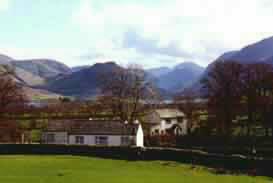
Retreat to the quiet of the Western Lakes

| An Autumn trekking holiday in India. Part 5 : A three day excursion to Agra and Jaipur Days: (15 - 17) . . . 7th to 9th November 2004 Holiday details : The final part of the holiday was a visit to the "Forts of Rajasthan" and involved a three day triangular excursion by train and car from Delhi to Agra, Jaipur and back to Delhi. Weather : Sunny and dry but long distance visibility was disappointing due to the ever present haze. |
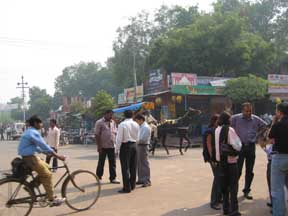 |
Back to the hustle and bustle of Indian life where we extended our holiday a few days to take in the tourist sights of Agra and Jaipur, the forts and temples of Rajasthan.
Back also to the lowlands and the people, not that there were any lack of them in the hills, its just that the geography of that region meant that more of the land was unsuitable for standing on !
After leaving the Imperial in Delhi we boarded an early morning train south to Agra where we were met by our chauffeur who would be with us for for the next few days. After a brief stop to deposit bags at the hotel, it was off through the city on a sight seeing tour. Our first stop was the Taj Mahal.
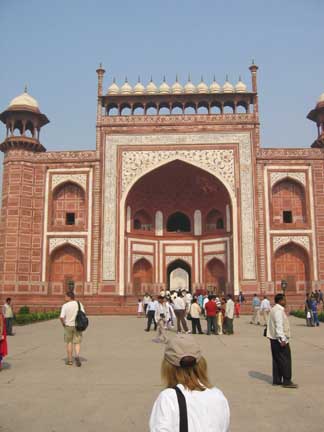 |
The entrance gate for the "seventh wonder of the world" The Mughal Emperor Shah Jahan was devastated by the death of his wife* that he built a marble shrine to hold her mortal remains. Beautifully designed, over 350 years ago, the Taj and its gardens are symmetrically laid out starting with this fine gateway. The building took twenty two years to build and uses red sandstone and local Indian marble, was beautifully designed, and even now is exquisitely decorated. (*Apparently she died giving birth to her fourteenth child at the age of 39 - a moral there somewhere) |
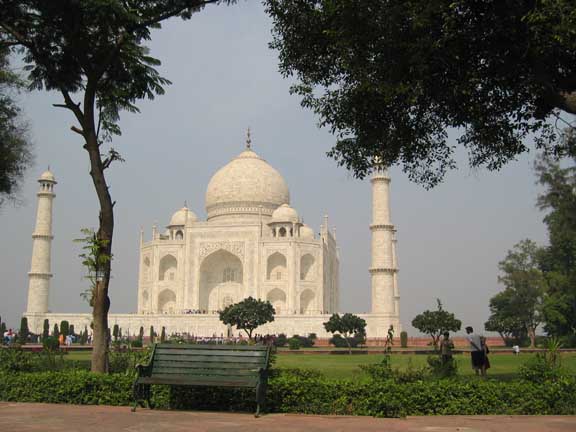
View from the garden.
Four beautiful minarets flank the amazing marble structure.
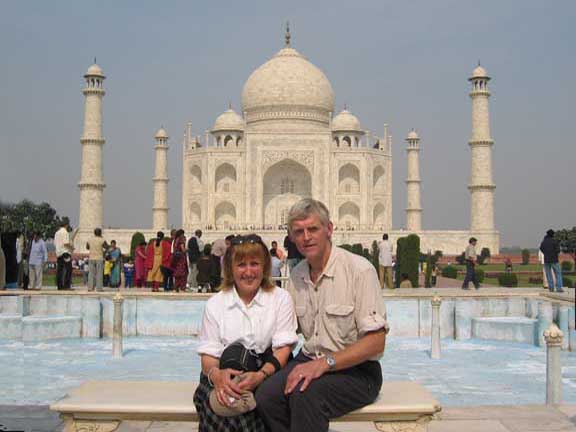
Ann and myself in classic pose on the marble "Diana" seat.
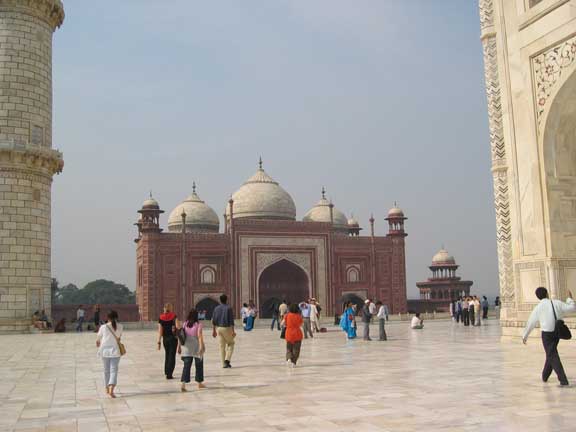
To either side of the main building are two sandstone buildings
one a small palace with accommodation, and the other a religious temple.
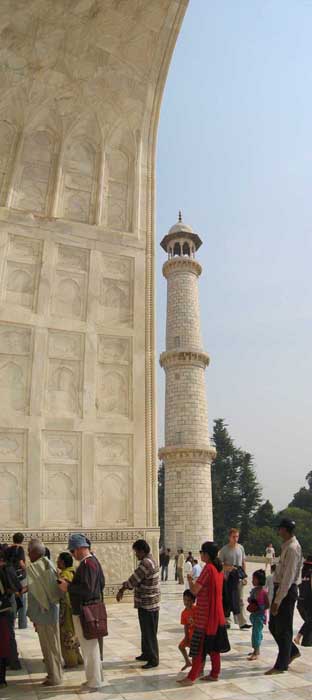 |
After leaving our shoes at the bottom steps we climbed onto the marble veranda and around the building itself.
The impressive nature of the building really becomes apparent when you get up close, as here under the entrance to the main building.
Not only is the stone work impressive, it is further enhanced by carvings and inlaid work using vast quantities of semi-precious stones.
|
|
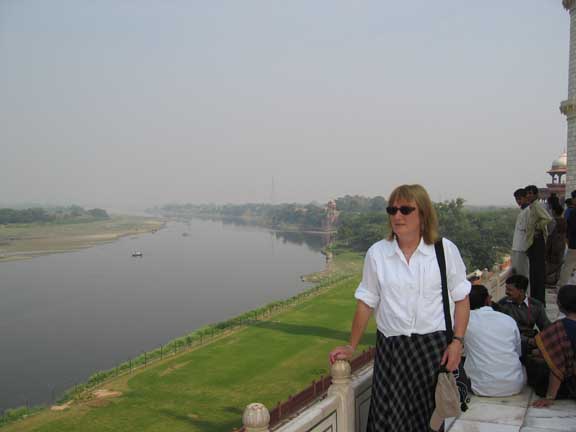
Ann looks out over the Yamuna River
from the terrace of the Taj Mahal.
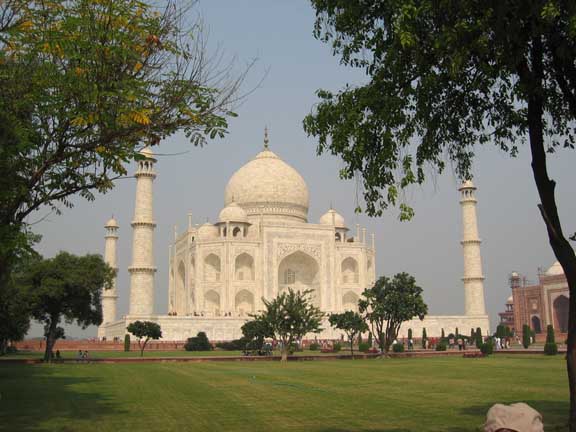
If ever a building had a justifiable reputation it was this one.
A truly magnificent structure.
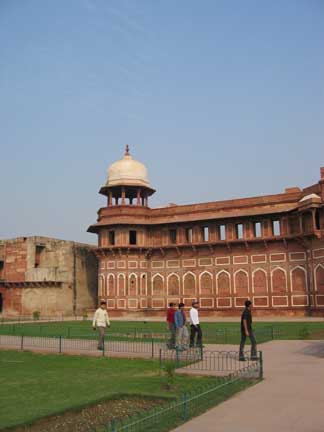 |
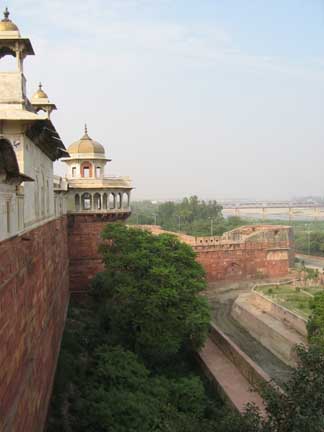 |
Next on our itinerary was the Red Fort at Agra.
Here its inner courtyard and outer walls.
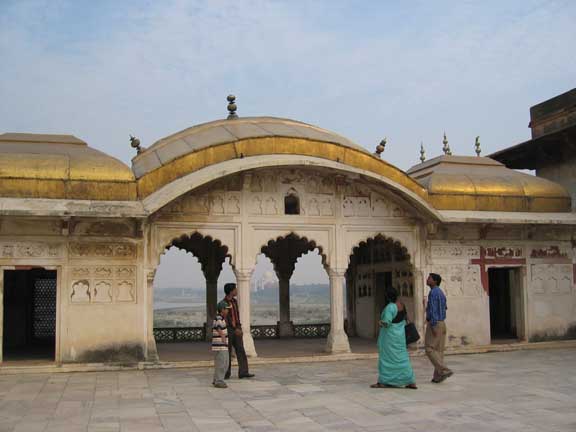
The restored roof over the Golden Pavilion
Through the archway can be seen the Taj Mahal.
Shah Jahan, the builder of the Taj, was imprisoned in Agra Fort by his son and could only spend his last years gazing at its structure from afar.
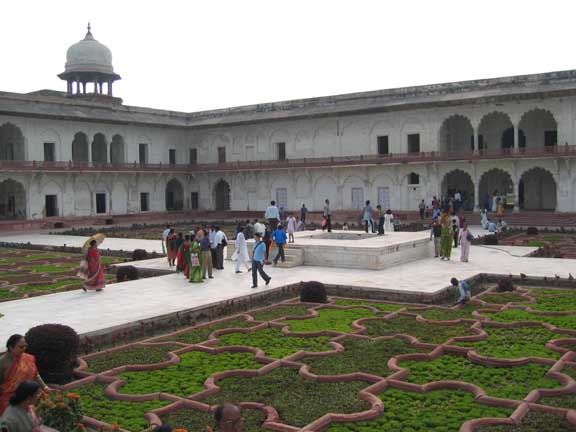
Restored gardens in the inner palace of the fort.
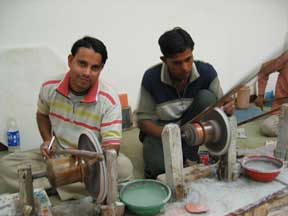 |
Following our visit to the historic city buildings we were invited to view a few workshops by our guide. Here the workers were keeping alive the skills of marble inlay. |
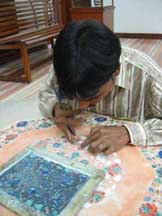 |
The workshop of course turned out to be just a front for a shop selling beautiful but expensive marble inlay work. We were intrigued by the technique but less than impressed by the pushy salesman.
Following that we visited another workshop / shop specialising on miniature painting. With the offer of having our names painted on a grain of rice, we spent a short time looking at the paintings but we were again feeling hassled, so after making a small purchase and collecting our rice we departed.
We visited a third making jewellery but passed on a fourth visit to a workshop for screen printing of fabrics, and escaped back to the hotel.
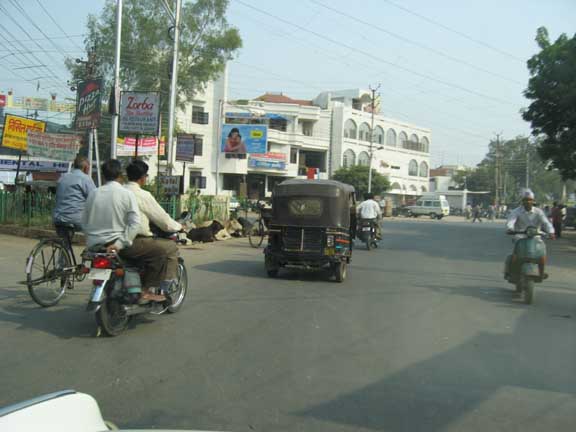
City traffic Agra style.
Priority seemed to be directly proportional to size; buses, cars, phut-phuts, motorbikes, cycles, people etc. However cattle here resting at the side of the road seemed to be a law unto themselves, getting up and moving about with a priority greater than everyone.
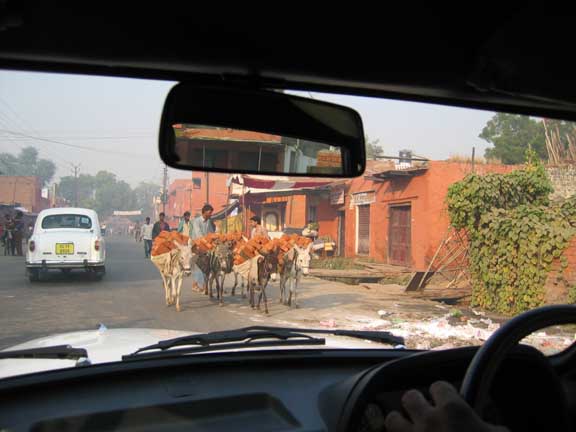
Next day we were on the move again, west to Jaipur.
We passed through a brick making region where there were clay pits, people hand making bricks, and many large chimneys of the firing kilns outside the villages. Here the donkeys were being used locally to deliver the bricks.
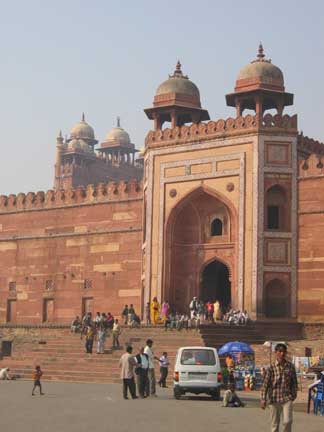
Fatephur Sikri, once the administrative capital was built by the Mughals over 400 yrs ago when the Emperor Akbar moved his Court to the City.
It was an important religious centre, home to the Holy Man Salim Christi. He was consulted about, amongst other things, a long awaited son and heir for the Emperor.
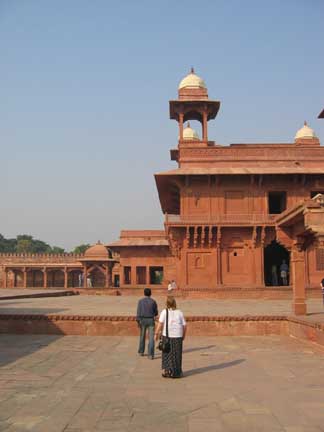 |
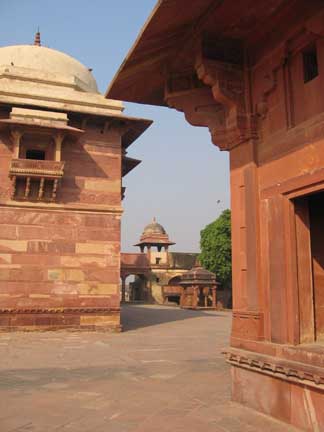 |
Beautiful red sandstone, hardly weathered at all by the forgiving climate of India formed into impressive palace buildings.
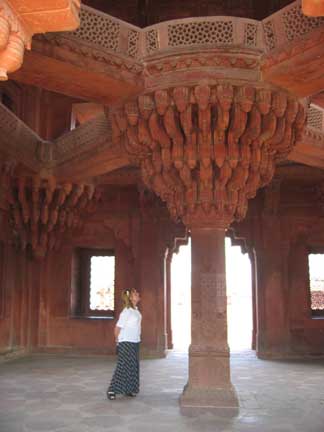 |
The palace was planned and built in the grand style of that time, and apart from being devoid of furniture and adornments, is in remarkably good condition.
Here an intricate stone pillar holding a gallery where the Emperor could hold court and look down on his subjects at the same time.
Akbar was a contemporary of our own Queen Elizabeth I. |
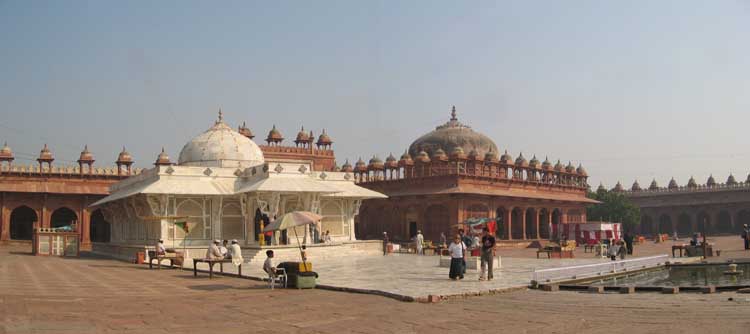
The Holy Man's predictions came true, Akbar got his son, and the Holy Man his saint-hood.
He was buried in the beautiful white marble shrine within the walls of the palace.
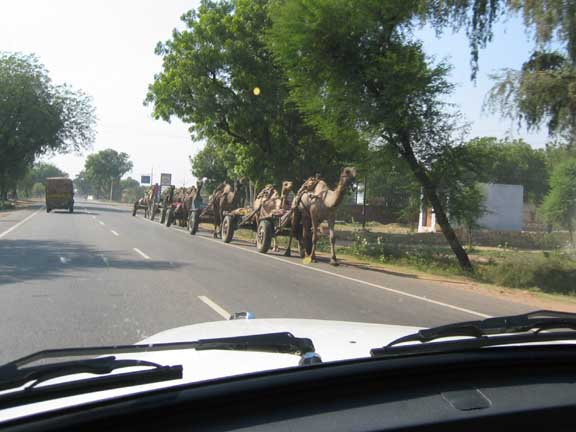
Onward and west to Jaipur City passing along good roads with a variety of traffic.
Here a group of seven camel carts plying their trade.
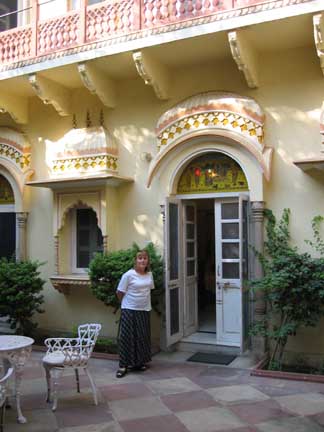
In the centre of Jaipur another haven from the outside world.
The bedroom door in the inner courtyard of the Haveli Hotel.
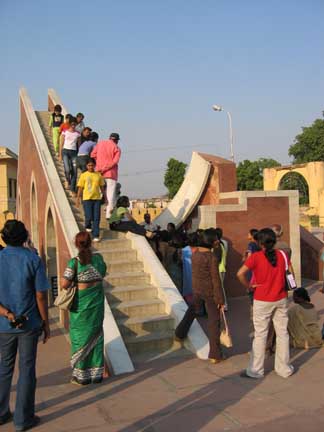 |
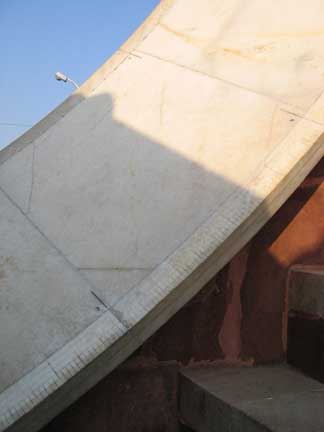 |
After a brief stop we were off again, visiting the attractions of the town.
This was an astrological observatory, the structure acting as an oversized sundial. The time measured on the curved white arc was accurate to within a few minutes.
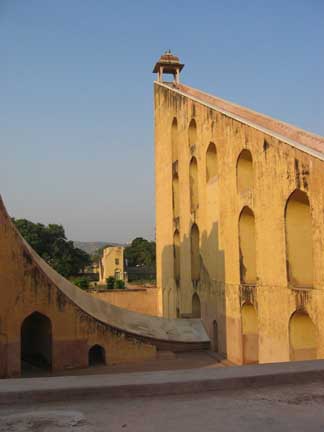
Make the sundial bigger and accuracy improved to better than twenty seconds.
Other structures measured and predicted the angles of the sun, moon and planets. Not bad for 400 yrs ago.
All this was important as astrology was a key driving force for the Ruling classes.
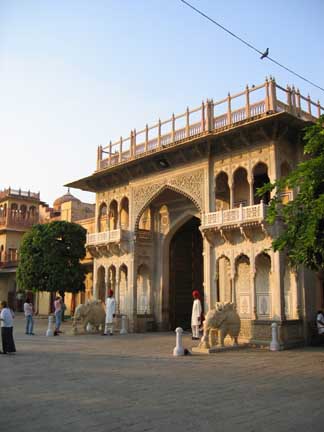 |
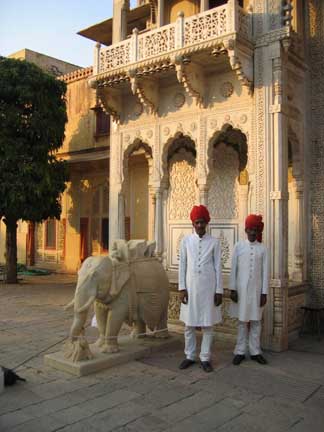 |
Entrance gates to the City Palace with two attendants and two beautifully carved elephants.
( Expecting to give a tip, I approached the left hand gentleman, asking for a photo. All of a sudden the second man rushed across unannounced to be in the photo. What should I do now, double the tip or let them share the one amount ?
Well . . . what would you do !)
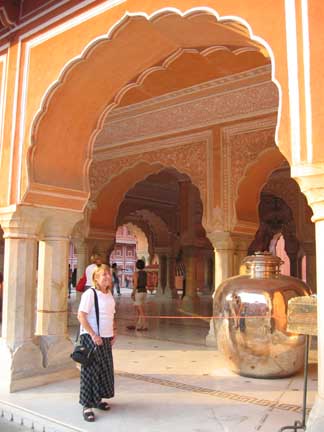
The building is the Diwan-i-Khas and houses these silver urns, said to be the largest silver objects in the world.
They were used to store local Jaipur drinking water and were taken with the Prince when he journey abroad. (They even travelled full of water to London in the fifties so Ann said)
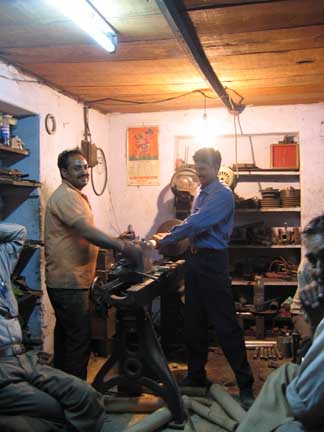 |
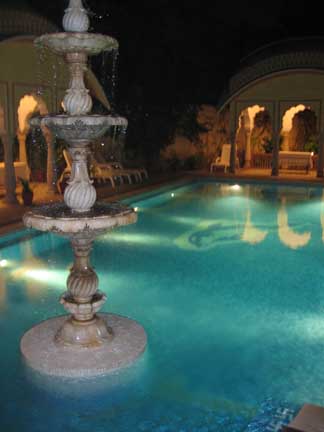 |
Indian Contrasts
- a small but busy workshop late at night in Jaipur - a fountain and swimming pool in the grounds of our hotel -
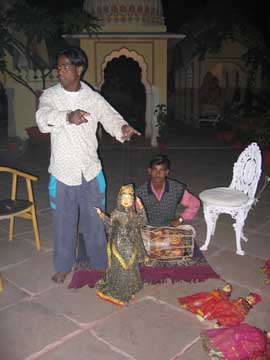 |
The puppet theatre. |
In the courtyard of the hotel these local men and youngsters were offering to entertain us.
Once they stopped pestering us we approached them and both gave us a some really memorable entertainment.
Young Rajasthan Dancers |
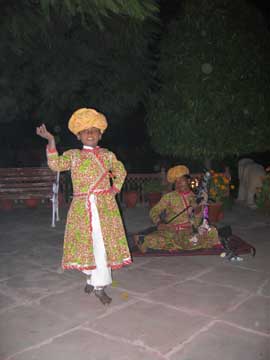 |
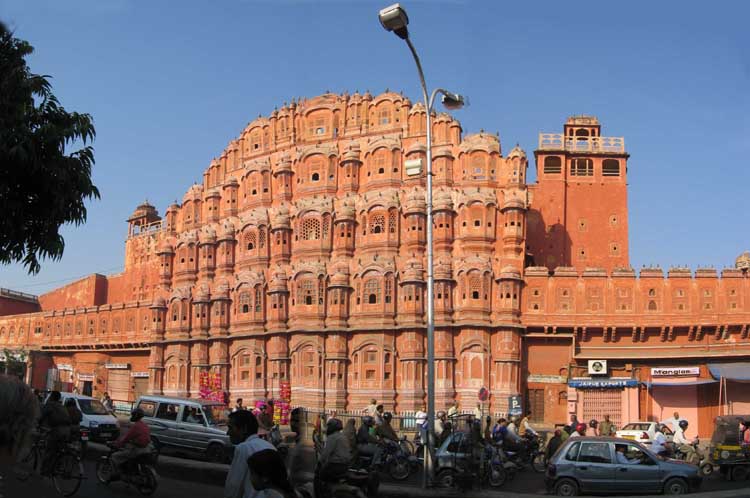
The Palace of the Winds - Hawa Mahal
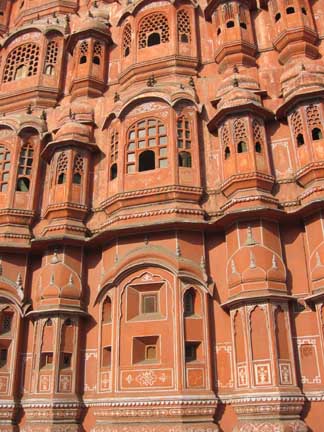 |
One of the most photographed monuments of the city, this five story building was part of the City Palace and allowed all of the Prince's wives to secretly view the goings on of the town from their individual rooms. Small or lace windows meant they could see without being seen. |
The town was built on a well planned and symmetrical structure, with straight roads and arcades of identical shops and workshops. Unlike other cities which have developed over time, it was a planned development from the start. It was built once the threat of invasion from Delhi was ended.
Untill then the rulers lived in the hilltop Amber Fort several miles out of the town.
The Amber Fort of Jaipur.
Click here or on image for a larger panorama
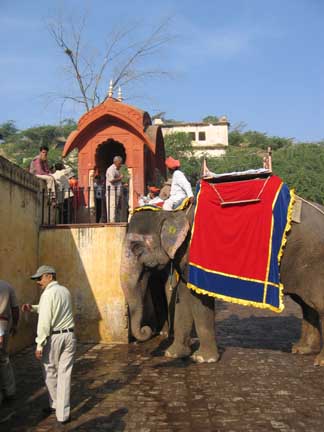 |
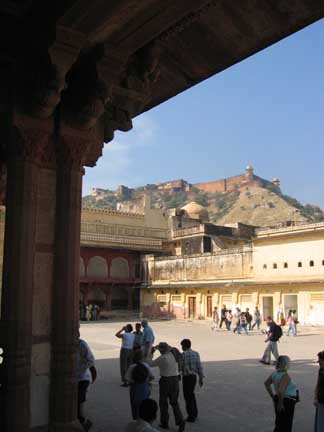 |
Our final sightseeing tour, complete with elephant ride up the hill and into the fort.
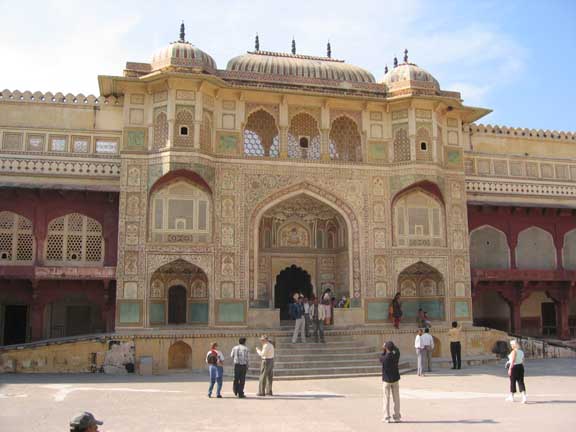
The ceremonial gate within the palace is still beautifully decorated.
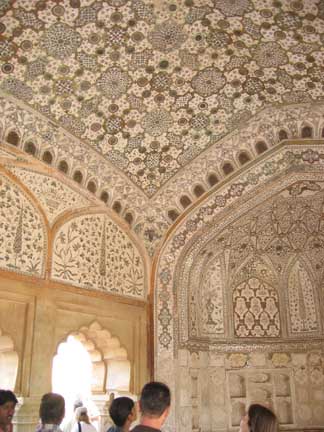 |
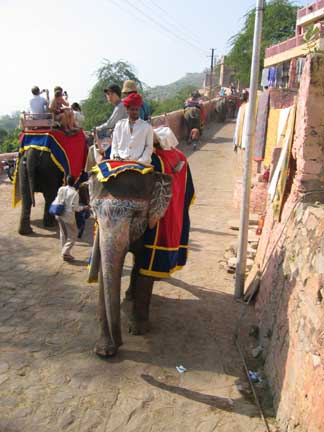 |
Inside there were rooms decorated with tiny mirrors which lit like stars under candle-light, and others in marble or red sandstone. We were expertly guided around as we had been all through the holiday.
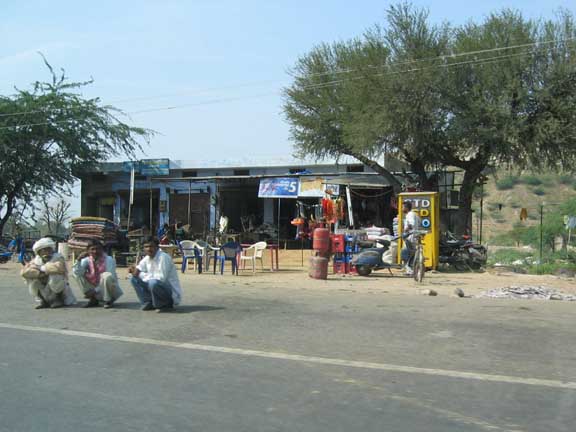
On the road again, back to Delhi.
Roadside scenes such as this were common all the way round, as small almost shanty like buildings served as shops, guesthouses, refreshment stops or made or sold or repaired any number of items.
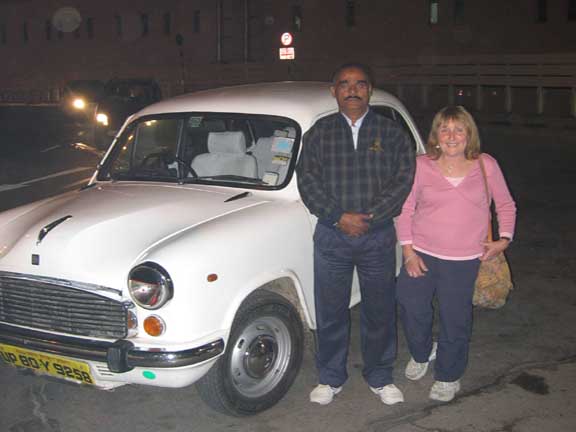
Ichbal - our driver for the three days
and last of the excellent series of guides and helpers on our holiday.
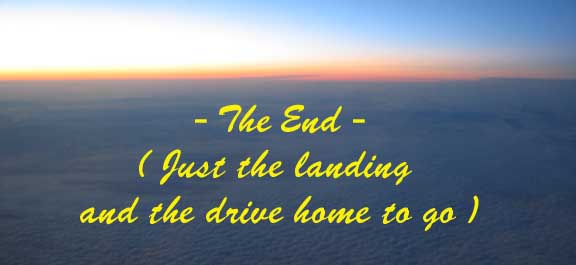
Postscript
We had a great holiday - not always enjoyable and relaxing, but very interesting nevertheless.
Compliments to K.E. Adventure Travel, To Rimo Expeditions in India, to all our guides and sherpas and to our fellow adventurers.
If you get the chance you must go to see for yourself - if only once.
Technical note: Pictures taken with a Canon IXUS 400 Digital camera.
Resized in Photoshop, and built up on a Dreamweaver web builder.
This site best viewed . . . with a 2005 brochure ?
Go to page 1 2 3 4 5 . . . Home page . . . Go To Archive 2004
© RmH . . . Email me here